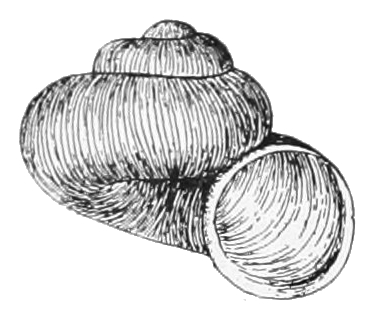Adaptation
Due to the similarity of adaptations and physiology of the terrestrial snails in the taxon Stylommatophora, and the lack of direct information about Millerelix plicata, the information that this page contains will be a on a more general view of terrestrial snails that are similar to Millerelix.
Snails that belong in the Stylommatophora taxon are terrestrial and have developed different
adaptations from their other gastropod cousins so that they may
better suit themselves for life on land. Snails similar to
Millerelix plicata follow
the typical body plan of snails in Stylommatophora
(Grzimek, 2004).
One of the most important adaptations that allow this group to
survive in their terrestrial environment, is the evolution of lungs.
However, even with lungs and the ability to breathe air on land,
snails in Stylommatophora adapted a solution against water loss by
creating a respiratory hole that can be shut to prevent water loss
and the production of a slime that keeps the body from evaporating
too much water (Nordisiek, 2010). Another adaptation seen in this
group is the appearance of retractile tentacles on the head
(Grzimek,
2004). The longer pair of tentacles houses the eyes at the tip and
deals with sight and olfactory senses (Grzimek, 2004). The bottom
pair of tentacles deals with finding food,
sensing
the environment, and following trails of potential mates during
reproduction (Grzimek, 2004). To move around, these snails possess a
foot ( also known as pedal) which lies beneath the shell and by
creating waves with the pedal muscles, the snail can achieve
locomotion (Barker, 2001).

The most obvious
adaptation would have to be the use of a calcareous shell.
Terrestrial snails, like
Millerelix plicata, evolved from ancestors with spiral shells
that contain several layers of organic and calcareous layers which are
produced by the mantle membrane of the snail
(Barker, 2001). The
last main adaption that is unique among gastropods, is torsion of
their body (Ghiselin, 1966). Torsion is an event that happens in a
snails life when the entire shell and all the organs within make a
180 degree turn until the posterior end of the shell is now anterior
(Ghiselin, 1966).
Millerelix plicata, originally
Polygyra plicata, belongs
to a group within Stylommatophora known as Polygyridae
(Myers,
Espinosa, Parr, Jones, Hammond, and Dewey, 2012). Polgyridae over
time has developed adaptations that differ from other snails in
Stylommatophora, such as a lack of a reproductive apparatus known as
the “love dart” (Nordisiek, 2010).
"Love darts" are used by snails to help initiate reproduction but
due to snails in Polygyridae being hermaphrodites, the "love darts"
are irrelevant (Dourson, 2010).
An adaptation that is unique to Millerelix, is the development of lipteeth. Lipteeth are two teeth-like protrusions that are found deeply placed in the outer lip and a short distance from the basal lip, and are what contributed to the common name, Cumberland Liptooth (Pilsbry, 1940). The shells of Millerelix plicata have been found to have about 5 whorls and dimensions between 2.8-3.1 mm in height and 5.5-7.7 mm in diameter (Pilsbry, 1940).
Please continue onto Nutrition to learn more.